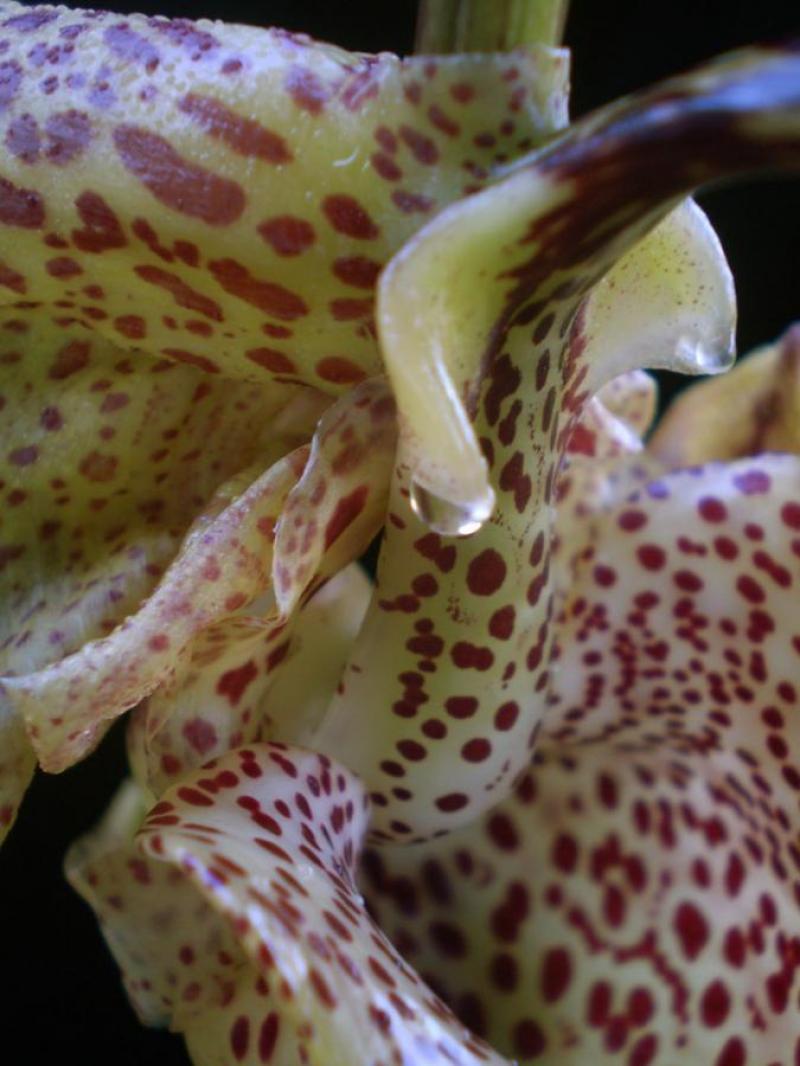Coryanthes macrantha
Also known as: The Bucket Orchid or Monkey Throat Orchid in Trinidad or Panstrepis paradoxa in the subfamily: Epidendroideae
Native to: Departamento del Huila - Colombia Loreto - Peru
General Information
The Bucket Orchid or Monkey Throat Orchid in Trinidad is a sympodial hot growing epiphytic orchid belonging to the sub family Epidendroideae native to Colombia and Peru.
Plant Description
Sympodial. Grows to 40cm. Each new growth has numerous leaves that grow to 30cm long. Pseudobulbs grow to 10cm
Flowers
Numerous fragrant blossoms appear
Fragrance
The orchid is fragrant.
Substrate(s)
- Bark
Care Notes
These orchids live in environments that receive constant moisture, high humidity, and are surrounded by other plants such as ferns and mosses which not only attract moisture but compete for it as well.
As a consequence they can be difficult to keep healthy in an artificial environment where a constant balance has to be maintained between providing constant moisture to the roots, but also allowing them to not become soggy and dry quickly as they would in the wild. For this reason it's important to take into account the size of the plant, the health and fragility of the root system, and also think about your watering habits. If you water frequently you can use a media that drains more freely, if you water less reliably you will need to find a media that offers retention and keeps humidity around the roots without being soggy.
Because these orchids like high amounts of water, other plants such as ferns and weeds may start to grow alongside the orchid, whose roots can make the media quite dense, effectively strangling the orchid's roots, it's best to pluck them out before they become a problem. Fungus and bacteria can be an issue as well, but usually are a sign of overwatering, smell the media occasionally to check, and increase airflow, reduce watering, and adjust temperatures accordingly (often bacteria only flourish in warmer temperatures, fungus less so).
Fragrant:
- IsFragrant
Climate
Grows at low to high elevations. Rainfall ranges from 81mm to 244mm per day, heaviest in May and lightest in January. Humidity ranges from 77% to 89%, highest in June and lowest in March. Temperature ranges from 18C to 32C, highest in February (21C to 32C) and lowest in September (18C to 30C).
Watering
These orchids prefer a constant supply of moisture, with a slight drying out between waterings. Saucers can be placed under pots to retain moisture during hot weather, however the saucers should be removed or let to dry every 1-2 weeks to prevent rot. Keep an eye on the plant especially in hot weather and look for cues of under/overwatering and adjust accordingly.
Fertiliser
Apply liquid based fertiliser per recommended directions. They can benefit from a high phosphate fertiliser leading up to flowering season, followed by a high nitrogen fertiliser when new growth appears, and a balanced fertiliser in other times. These orchids can also tolerate slow release fertiliser applied 1-2 pellets per cup (250ml) of media.
Be sure to flush out excess fertiliser by running water through the media regularly year round. Apply fertiliser regularly at half strength year round. Use a high Nitrogen fertiliser during Spring and Summer. Use a high Phosphorous fertiliser during Summer. Reduce fertiliser when plant is dormant during Spring.Potting
These plants are quite forgiving and will do well repotted ever 2-3 years. The mix should be coarse, well draining, and allow space for air to move and for roots to grow.
Alternatively, these plants will also do well mounted to tree fern or cork slabs, or mounted to trees.
Best time for repotting or mounting the orchids is the end of winter when new growths start to appear. Avoid repotting during hot weather,
This plant does well mounted.




















